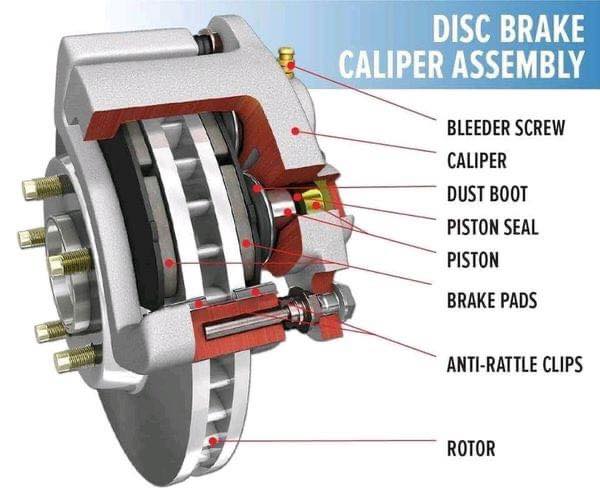DISC BRAKES

Disc brakes are a type of brake system that uses calipers to squeeze pairs of pads against a disc (also known as a "rotor") to create friction, slowing the vehicle. They are called "disc brakes" because of the rotor, which is shaped like a flat disc. The friction between the brake pads and the disc reduces the rotational speed of the wheel and, in turn, slows down or stops the vehicle.
Here's a basic breakdown of how they work:
When you press the brake pedal, brake fluid from the master cylinder creates hydraulic pressure.
This hydraulic pressure is transmitted through the brake lines to the calipers.
The pressure forces the brake pads inside the caliper to clamp onto the rotating disc. This creates friction.
The friction slows the rotation of the disc, and thus the wheel, stopping or slowing down the vehicle.
Disc brakes are generally more efficient at dissipating heat compared to drum brakes, which improves their performance, particularly during high-demand situations such as descending steep hills or when stopping from high speeds. Because of their efficiency and performance advantages, disc brakes are commonly used on the front wheels of modern vehicles, and often on all four wheels.
Disc brake components are also more easily inspected and serviced than drum brakes. However, they can be more expensive to manufacture and service because of their complexity. Despite this, the advantages of disc brakes, such as their strong stopping power and better heat dissipation, make them a popular choice in many modern vehicles.
Disc brakes are a type of brake system that uses calipers to squeeze pairs of pads against a disc (also known as a "rotor") to create friction, slowing the vehicle. They are called "disc brakes" because of the rotor, which is shaped like a flat disc. The friction between the brake pads and the disc reduces the rotational speed of the wheel and, in turn, slows down or stops the vehicle.
Here's a basic breakdown of how they work:
When you press the brake pedal, brake fluid from the master cylinder creates hydraulic pressure.
This hydraulic pressure is transmitted through the brake lines to the calipers.
The pressure forces the brake pads inside the caliper to clamp onto the rotating disc. This creates friction.
The friction slows the rotation of the disc, and thus the wheel, stopping or slowing down the vehicle.
Disc brakes are generally more efficient at dissipating heat compared to drum brakes, which improves their performance, particularly during high-demand situations such as descending steep hills or when stopping from high speeds. Because of their efficiency and performance advantages, disc brakes are commonly used on the front wheels of modern vehicles, and often on all four wheels.
Disc brake components are also more easily inspected and serviced than drum brakes. However, they can be more expensive to manufacture and service because of their complexity. Despite this, the advantages of disc brakes, such as their strong stopping power and better heat dissipation, make them a popular choice in many modern vehicles.
See Insights
Boost a Post
All reactions:114114
See Insights
Boost a Post
All reactions:114114

 Loading..
Loading..